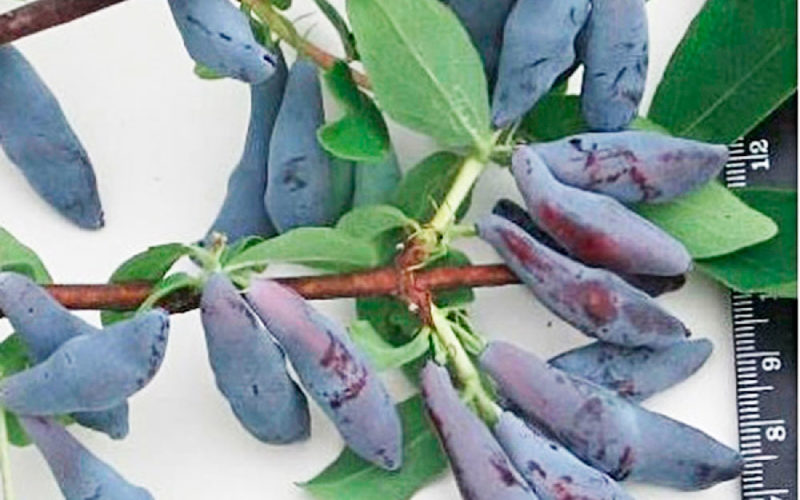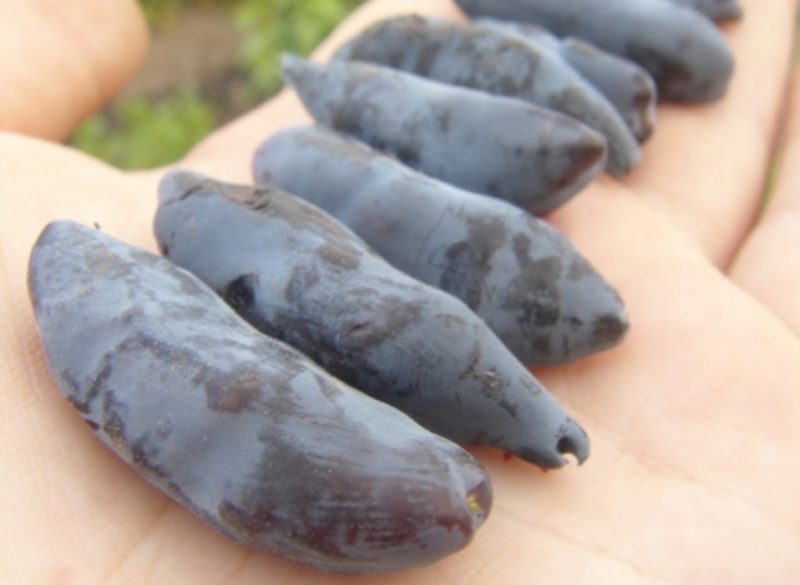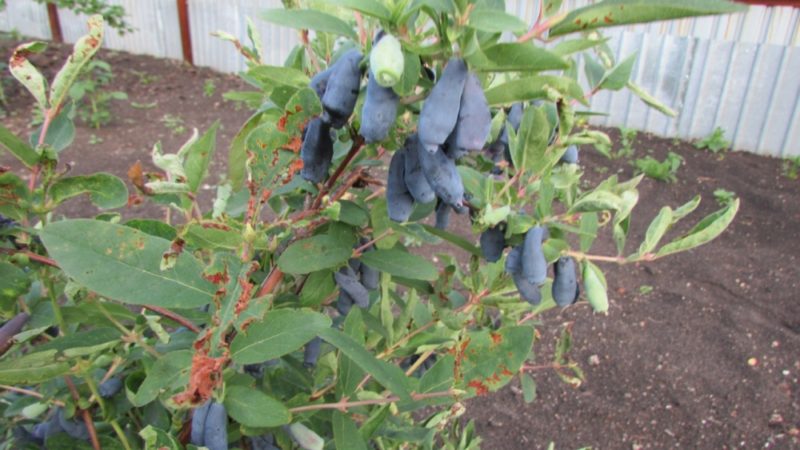The honeysuckle “Pride of Bakchar” was included in the state register of selection achievements in 2006. Since then, you can hear a lot of good reviews about its virtues from lovers and professionals of gardening.
Material Content:
Description of the honeysuckle variety “Pride of Bakchar”
This honeysuckle belongs to the Siberian group of varieties, it can often be found in personal plots.
Large berries are 4 cm long, weigh 1.2 g and are distinguished by their exquisite dessert taste, without bitterness, the acid and sweetness in them are well balanced.
The shape of the crown is semicircular, about 1.6 in height, young thin branches wilt under the weight of the fruit. Harvest ripens in mid-July. The disadvantage can be considered the crumbling fruit. From the moment the first berries ripen, they need to be collected daily in a small amount. The shrub will give a full crop (from 1.8 to 2.6 kg) within a month. Fruiting begins at 5 years of age and reaches maximum intensity at 8-10 years.
 The variety was obtained on the basis of the southern coastal blue honeysuckle population. The berries are elongated in shape, resemble a spindle, painted purple with a light wax coating, the skin is dense. The fruits have many healthy R-active substances - catechins, anthocyanins, etc. Delicious winter preparations are made from berries: jams, juices, wines, compotes, jams.
The variety was obtained on the basis of the southern coastal blue honeysuckle population. The berries are elongated in shape, resemble a spindle, painted purple with a light wax coating, the skin is dense. The fruits have many healthy R-active substances - catechins, anthocyanins, etc. Delicious winter preparations are made from berries: jams, juices, wines, compotes, jams.
Outdoor landing
The most favorable planting period for edible species of the Honeysuckle family is considered to be the period from late summer to mid autumn. Well-developed seedlings in containers are bought in the nursery. Such plants are transplanted to a permanent place by transshipment. Sometimes seedlings are sold by mail, packing the roots in peat. In this case, the substrate needs to be well shaken off, and the roots should be straightened when planting.
Planting pits can be placed in a row at a distance of 1.5 m from each other - you get a hedge. Choose a bright place where there is a loose and fertile soil with an acidity of 7.5-8.5.
Landing Features:
- the size of the hole should be larger than the parameters of the root system (approximately 25 cm deep and the same in diameter);
- the root neck cannot be deepened;
- about 3 kg of humus is added to the hole, mixing with garden soil;
- at the bottom, drainage is made of gravel or broken brick with a layer of 5 cm.
Several varieties of honeysuckle are planted on the site, without this crop there will be no, since cross pollination is required. For “Pride of Bakchar” good pollinators are “Blue Bird”, “Blue Spindle”, “Delight”, “Bakcharsky Giant”.
Shrub care
Honeysuckle is unpretentious, it is a pleasure to grow it in central Russia. If the soil is loose and fertile, and the place is protected from the wind and well lit, you can not worry about the health of the bush and the future crop.
It is advisable to feed the honeysuckle at least 3 times during the growing season:
- in the spring - with complex fertilizer;
- before flowering - the drug "Kemira-universal";
- in late summer or early autumn - wood ash, superphosphate and potassium salt.
 Watering should be moderate, but regular, especially during flowering and ripening of the crop. If the soil dries up, in the fruits, in addition to the sweet and sour taste, bitterness will appear. In dry summers, about 8 liters of water are poured under each bush. Then weeds are removed, the soil in the near-stem circle is loosened and mulched.
Watering should be moderate, but regular, especially during flowering and ripening of the crop. If the soil dries up, in the fruits, in addition to the sweet and sour taste, bitterness will appear. In dry summers, about 8 liters of water are poured under each bush. Then weeds are removed, the soil in the near-stem circle is loosened and mulched.
Pruning is done in autumn or early spring, removing broken and diseased branches. It is not recommended to cut the ends of healthy shoots, as they have many flower buds.
Breeding methods
Edible honeysuckle propagated by cuttings. A young plant under the age of 5 can be propagated by dividing the bush - with an autumn transplant, the pruning shears are cut into dividers.
Features of the harvesting and rooting of cuttings:
- Cuttings begin to be harvested during the appearance of green fruits, by this time the branches ripen and do not rot when rooted in a moist substrate.
- For cuttings choose strong shoots of the current year.
- One long branch is cut into pieces 10-12 cm long.
- The lower cut is made oblique, and the upper one is straight.
- The lower leaves are removed, the upper ones are shortened by half.
- Plant fresh cuttings in a moist substrate of peat and sand.
- Maintain high humidity of air and soil prior to rooting, making the greenhouse from a glass jar or a transparent bag.
- They create diffused lighting and an air temperature of 20–25 ° C.
Rooting usually occurs in 10-14 days. Cuttings begin to harden, gradually removing the greenhouse. In open ground, honeysuckle is planted for 2 years of cultivation, in the fall.
Pest and Disease Control
With proper planting and good care, honeysuckle is rarely sick. However, pests and diseases can get into with poor-quality planting material, dirty garden tools, or in some other way. Infected plants will need help, so you need to be aware of potential problems.
Common fungal diseases:
- ramulariosis - brown spots on the leaves;
- cercosporosis - rounded brown spots;
- powdery mildew - a white coating, more intense on the underside of the leaves.
For prevention, shrubs are sprayed in early spring with a solution of copper sulfate or “Fundazol”.
Powdery mildew is helped by wood ash, colloidal sulfur, or Topaz fungicide.
- leaf-eating caterpillars;
- honeysuckle tick;
- scale shield;
- honeysuckle aphids.
During the ripening of the crop, insecticides can not be used, the bushes are sprayed with infusion of tops of tomatoes or potatoes. Preventive treatment is preferably carried out in early spring using insectoacaricides.
The honeysuckle of the Pride of Bakchar variety is easy to care for, it will take its rightful place in the garden. Her berries are tasty and healthy, can be used for winter harvesting.













